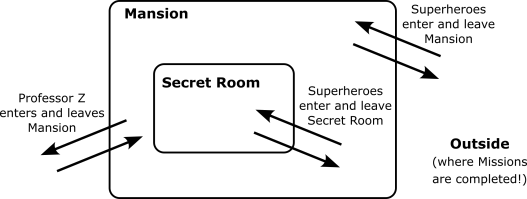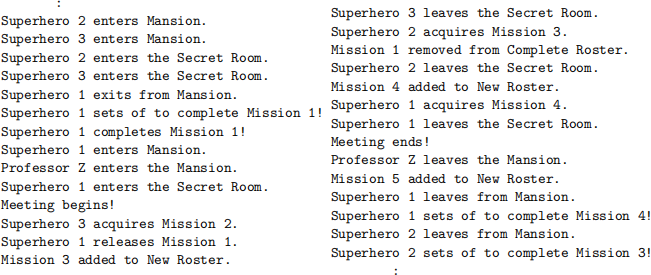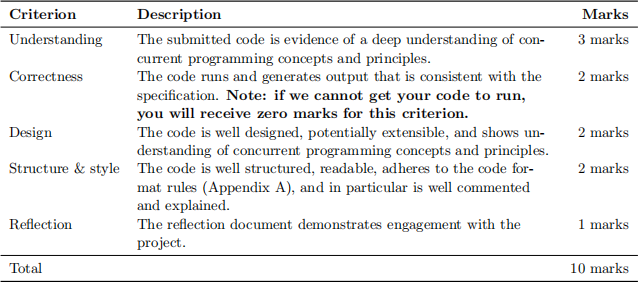SWEN90004 Modelling Complex Software Systems Assignment 1a, 2023
Hello, dear friend, you can consult us at any time if you have any questions, add WeChat: daixieit
SWEN90004 Modelling Complex Software Systems
Assignment 1a, 2023
Released: Thursday 2 March, 2023. Deadline: 23:59, Thursday 23 March, 2023
Objectives
The objectives of this assignment are: to convert a description of a system into a simulation model of that system; to implement that simulation in a shared memory concurrent programming language; to use the implemented simulation to explore the behaviour of the system; to gain a better understand- ing of safety and liveness issues in concurrent systems.
Background and context
There are two parts to Assignment 1. This first part of the assignment (ie, this part) deals with pro- gramming threads in Java, and is worth 10% of your final mark. The second part of the assignment (to be released in a few weeks) deals with modelling in FSP, and is worth 15% of your final mark. Your task is to implement a concurrent simulation of Professor Z and their league of superheroes.
The system to simulate
In an alternate version of our Earth, a genetic mutation causes some people, known as Z-folk, to be born with superhuman abilities which they use to fight crime. These Superheroes are led by Profes- sor Z, whose Mansion they regularly gather in discuss world affairs. Within the Mansion is a Secret Room, where Professor Z and the superheroes meet to allocate crime-fighting Missions.
Within the Mansion, Professor Z and the superheroes interact according to a set of strict rules. Su-perheroes enter the Mansion, discuss world affairs, and enter the Secret Room (see Figure 1 for a schematic of the system). While Professor Z is in the Mansion, no more superheroes may enter or leave the Mansion. Once all superheroes who are present in the Mansion have also entered the Secret Room, Professor Z starts a meeting in the Secret Room. During a meeting, superheroes report back on and release their completed Missions (if they had one) and acquire new Missions. Once a super-hero has acquired a new Mission, they may leave the Secret Room, and spend more time discussing world affairs. Once all superheroes have left the Secret Room, Professor Z ends the meeting and, at some point after this, leaves the Mansion. The superheroes are then free to leave the Mansion and complete their Missions. After completing a Mission, a superhero once more returns to the Mansion, and the process begins again.
Your tasks
Your task is to implement a simulator for the system described above. It should be suitably parame- terised such that the timing assumptions can be varied, and the number of superheroes can be varied. You should use your simulator to explore the behaviour of the system to identify any potential prob- lems with its operation.
Note: you should observe problems if you simulate the system as described — you are not required to fix them as part of this assignment! (though you are encouraged to think about how you might do so) .
You may assume that:
1. Superheroes may only enter the Secret Room after first entering the Mansion.

Figure 1: A schematic of the system, showing the relationship between the Mansion, where Super-heroes gather to discuss world affairs, the Secret Room, where meetings are held to allow Superheroes to acquire and release Missions, and the outside world, where Missions are completed by Superheroes.
2. Superheroes may only leave the Mansion after first leaving the Secret Room.
3. Superheroes can only acquire or release Missions while they are in the Secret Room and a meet- ing is in progress.
4. A Superhero may only have one Mission (completed or uncompleted) at a time.
5. Superheros who are currently on a Mission will not return to the Mansion until it is complete.
6. Not all superheroes are required to be in the Mansion before a meeting can start.
7. A pair of Rosters, for new and completed Missions respectively, is used to handle Missions dur- ing a meeting.
8. Professor Z does not need to enter or leave the Secret Room; they only need to be in the Man- sion in order to start a meeting.
9. Professor Z does not leave the mansion while a meeting is in progress.
The simulator should produce a trace of events matching that below (here shown in two columns). Before this section of the trace, Superhero 1 had acquired Mission 1 in a previous meeting. Not that, after Professor Z entered the Mansion, the meeting could not begin until Superhero 1 had entered the Secret Room. The meeting ended once there were no Superheroes left in the Secret Room, but none of the Superheroes could leave the Mansion until Professor Z had left.

A possible design and suggested components
In the context of Java, it makes sense to think of the Mansion and Rosters as monitors. The other
components of the system could then be implemented as active processes (i.e., Threads). We have made some scaffold code available on LMS, which provides:
Producer .java Generates new Missions and adds them to the new mission Roster.
Consumer.java: Removes Missions that have been completed from the completed mission Roster. Mission.java: Missions can be generated as instances of this class.
Params.java: A class which, for convenience, gathers together various system-wide parameters, in- cluding time intervals.
Main.java: The overall driver of the simulation. Note that this won’t compile until you have defined some additional classes.
System parameters:
The class Params .java contains the system parameters, including the number of rooms and a number of timing parameters. Varying these parameters will give you different system behaviours. Once you have a working simulator, you should experiment with the parameter settings.
Procedure and assessment
• The project should be done by students individually.
• Late submissions will attract a penalty of 1 mark for every calendar day it is late. If you have a reason that you require an extension, email Nic well before the due date to discuss this.
• You should submit a single zip file via LMS. The zip file should include:
1. A single directory containing all Java source files needed to create a file called Main .class, such that “javac * .java” will generate Main .class, and “java Main” will start the simu- lator.
2. A plain text file reflection .txt should contain approximately 500 words that discusses the potential problems that can arise in this system, drawing on observations of your sim- ulator behaviour. You could also use this text to evaluate the success or otherwise of your solution, identify critical design decisions or problems that arose, and summarise any other insights from experimenting with the simulator. Please ensure that this is a plain text file; ie, not a doc, docx, rtf, or other file type that requires specific software to read.
All source files and your text file should contain, near the top of the file, your name and student number.
• We encourage the use of the Ed discussion board for discussions about the project. However, all submitted work must be your own individual work.
• This project counts for 10 of the 50 marks allocated to project work in this subject. Marks will be awarded according to the following guidelines:

A Code format rules
Your implementation must adhere to the following simple code format rules:
• Every Java class must contain a comment indicating its purpose.
• Every method must contain a comment at the beginning explaining its behaviour. In particular, any assumptions should be clearly stated.
• Constants, class, and instance variables must be documented.
• Variable names must be meaningful.
• Significant blocks of code must be commented.
However, not every statement in a program needs to be commented. Just as you can write too few comments, it is possible to write too many comments.
• Program blocks appearing in if-statements, while-statements, etc., must be indented consis-tently. They can be indented using tabs or spaces, and can be indented 2, 4, or 8 spaces, as long as it is done consistently.
• Each line must contain no more than 100 characters (Google Java Style Guide).
2023-03-23